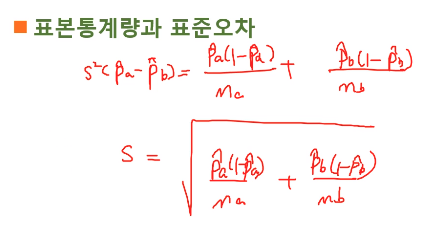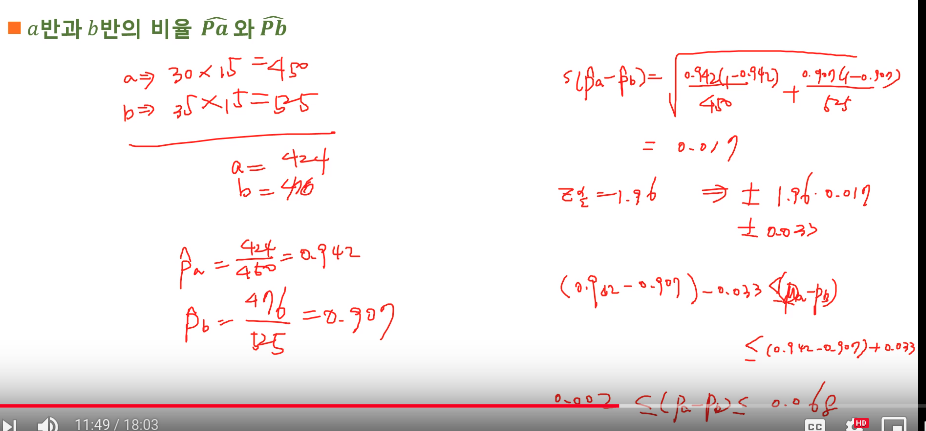This is personal study note
Copyright and original reference:
https://www.youtube.com/watch?v=k6cj3yBXm1k&list=PLsri7w6p16vvQCo9pmuRNY_SYoOGB6bWM&index=6
================================================================================
Is there ratio difference between 2 populations?
 ================================================================================
Suppose population A has ratio A ($$$P_A$$$)
Suppose population B has ratio B ($$$P_B$$$)
You want to know $$$P_A-P_B$$$
To do it, can you calculate $$$P_A-P_B$$$ by using $$$\hat{P}_A-\hat{P}_B$$$?
================================================================================
Hypothesis
2 side test
$$$H_0:P_A-P_B=0$$$
$$$H_1:P_A-P_B\ne 0$$$
left side test
$$$H_0:P_A-P_B=0$$$
$$$H_1:P_A-P_B\lt 0$$$
right side test
$$$H_0:P_A-P_B=0$$$
$$$H_1:P_A-P_B\gt 0$$$
================================================================================
Example
================================================================================
Suppose population A has ratio A ($$$P_A$$$)
Suppose population B has ratio B ($$$P_B$$$)
You want to know $$$P_A-P_B$$$
To do it, can you calculate $$$P_A-P_B$$$ by using $$$\hat{P}_A-\hat{P}_B$$$?
================================================================================
Hypothesis
2 side test
$$$H_0:P_A-P_B=0$$$
$$$H_1:P_A-P_B\ne 0$$$
left side test
$$$H_0:P_A-P_B=0$$$
$$$H_1:P_A-P_B\lt 0$$$
right side test
$$$H_0:P_A-P_B=0$$$
$$$H_1:P_A-P_B\gt 0$$$
================================================================================
Example

 * Presence frequence in university A
* Unit: number of people
* a class (Presence is checked by smartphone), b class (Presence is checked by raising a hand)
================================================================================
$$$H_0: p_a - p_b = 0$$$
$$$H_1: p_a - p_b \ne 0$$$
================================================================================
number of samples
$$$n_a, n_b$$$
================================================================================
expectation value
$$$ E(\hat{p}_a - \hat{p}_b) = p_a-p_b$$$
================================================================================
variance
$$$\sigma^2(\hat{p}_a-\hat{p}_b) \\
= \sigma^2(\hat{p}_a) + \sigma^2(\hat{p}_b) \\
= \dfrac{\hat{p}_a(1-\hat{p}_a)}{n_a} + \dfrac{\hat{p}_b(1-\hat{p}_b)}{n_b}$$$
================================================================================
test statsitics z
$$$z = \dfrac{ (\hat{p}_a - \hat{p}_b) - (p_a - p_b) }{\sqrt{\dfrac{\hat{p}_a(1-\hat{p}_a)}{n_a} - \dfrac{\hat{p}_b(1-\hat{p}_b)}{n_b} }}$$$
================================================================================
* Presence frequence in university A
* Unit: number of people
* a class (Presence is checked by smartphone), b class (Presence is checked by raising a hand)
================================================================================
$$$H_0: p_a - p_b = 0$$$
$$$H_1: p_a - p_b \ne 0$$$
================================================================================
number of samples
$$$n_a, n_b$$$
================================================================================
expectation value
$$$ E(\hat{p}_a - \hat{p}_b) = p_a-p_b$$$
================================================================================
variance
$$$\sigma^2(\hat{p}_a-\hat{p}_b) \\
= \sigma^2(\hat{p}_a) + \sigma^2(\hat{p}_b) \\
= \dfrac{\hat{p}_a(1-\hat{p}_a)}{n_a} + \dfrac{\hat{p}_b(1-\hat{p}_b)}{n_b}$$$
================================================================================
test statsitics z
$$$z = \dfrac{ (\hat{p}_a - \hat{p}_b) - (p_a - p_b) }{\sqrt{\dfrac{\hat{p}_a(1-\hat{p}_a)}{n_a} - \dfrac{\hat{p}_b(1-\hat{p}_b)}{n_b} }}$$$
================================================================================
 $$$s^2(\hat{p}_a - \hat{p}_b)
= \dfrac{\hat{p}_a(1-\hat{p}_a)}{n_a} + \dfrac{\hat{p}_b(1-\hat{p}_b)}{n_b}$$$
$$$s = \sqrt{\dfrac{\hat{p}_a(1-\hat{p}_a)}{n_a} + \dfrac{\hat{p}_b(1-\hat{p}_b)}{n_b}}$$$
================================================================================
Confidence interval
$$$s^2(\hat{p}_a - \hat{p}_b)
= \dfrac{\hat{p}_a(1-\hat{p}_a)}{n_a} + \dfrac{\hat{p}_b(1-\hat{p}_b)}{n_b}$$$
$$$s = \sqrt{\dfrac{\hat{p}_a(1-\hat{p}_a)}{n_a} + \dfrac{\hat{p}_b(1-\hat{p}_b)}{n_b}}$$$
================================================================================
Confidence interval
 $$$(\hat{p}_a - \hat{p}_b) - z_{\frac{\alpha}{2}} \times \sqrt{\dfrac{\hat{p}_a(1-\hat{p}_a)}{n_a} + \dfrac{\hat{p}_b(1-\hat{p}_b)}{n_b}}
\le p_a - p_b
\le (\hat{p}_a + \hat{p}_b) - z_{\frac{\alpha}{2}} \times \sqrt{\dfrac{\hat{p}_a(1-\hat{p}_a)}{n_a} + \dfrac{\hat{p}_b(1-\hat{p}_b)}{n_b}}$$$
================================================================================
Calculation
$$$(\hat{p}_a - \hat{p}_b) - z_{\frac{\alpha}{2}} \times \sqrt{\dfrac{\hat{p}_a(1-\hat{p}_a)}{n_a} + \dfrac{\hat{p}_b(1-\hat{p}_b)}{n_b}}
\le p_a - p_b
\le (\hat{p}_a + \hat{p}_b) - z_{\frac{\alpha}{2}} \times \sqrt{\dfrac{\hat{p}_a(1-\hat{p}_a)}{n_a} + \dfrac{\hat{p}_b(1-\hat{p}_b)}{n_b}}$$$
================================================================================
Calculation
 a class: 30 people $$$\times$$$ 15 weeks = 450 people
a class: 35 people $$$\times$$$ 15 weeks = 525 people
actual presence:
a class: 424 people
b class: 476 people
$$$\hat{p}_a = \dfrac{424}{450} = 0.942$$$
$$$\hat{p}_b = \dfrac{476}{525} = 0.907$$$
standard error
$$$s(\hat{p}_a - \hat{p}_b) \\
= \sqrt{\dfrac{\hat{p}_a(1-\hat{p}_a)}{n_a} + \dfrac{\hat{p}_b(1-\hat{p}_b)}{n_b}}\\
= \sqrt{\dfrac{0.942(1-0.942)}{450} + \dfrac{0.907(1-0.907)}{525}} \\
= 0.017$$$
$$$z_{\frac{\alpha}{2}} = 1.96$$$ $$$\Rightarrow$$$ $$$\pm 1.96 \times 0.017 = \pm 0.033 $$$
$$$(0.942 - 0.907) - 0.033 \le p_a-p_b \le (0.942 - 0.907) + 0.033$$$
$$$0.002 \le p_a-p_b \le 0.068$$$
================================================================================
Test hypothesis
a class: 30 people $$$\times$$$ 15 weeks = 450 people
a class: 35 people $$$\times$$$ 15 weeks = 525 people
actual presence:
a class: 424 people
b class: 476 people
$$$\hat{p}_a = \dfrac{424}{450} = 0.942$$$
$$$\hat{p}_b = \dfrac{476}{525} = 0.907$$$
standard error
$$$s(\hat{p}_a - \hat{p}_b) \\
= \sqrt{\dfrac{\hat{p}_a(1-\hat{p}_a)}{n_a} + \dfrac{\hat{p}_b(1-\hat{p}_b)}{n_b}}\\
= \sqrt{\dfrac{0.942(1-0.942)}{450} + \dfrac{0.907(1-0.907)}{525}} \\
= 0.017$$$
$$$z_{\frac{\alpha}{2}} = 1.96$$$ $$$\Rightarrow$$$ $$$\pm 1.96 \times 0.017 = \pm 0.033 $$$
$$$(0.942 - 0.907) - 0.033 \le p_a-p_b \le (0.942 - 0.907) + 0.033$$$
$$$0.002 \le p_a-p_b \le 0.068$$$
================================================================================
Test hypothesis
 Rejection area
$$$|\pm 1.96| \gt |z|$$$
$$$z \\
= \dfrac{(0.942-0.907) - 0}{\sqrt{\frac{0.942 \times (1-0.942)}{450} + \frac{0.907 \times (1-0.907)}{525}}} \\
= \frac{0.035}{0.017} \\
= 2.059$$$
$$$H_0$$$ is rejected
Rejection area
$$$|\pm 1.96| \gt |z|$$$
$$$z \\
= \dfrac{(0.942-0.907) - 0}{\sqrt{\frac{0.942 \times (1-0.942)}{450} + \frac{0.907 \times (1-0.907)}{525}}} \\
= \frac{0.035}{0.017} \\
= 2.059$$$
$$$H_0$$$ is rejected






